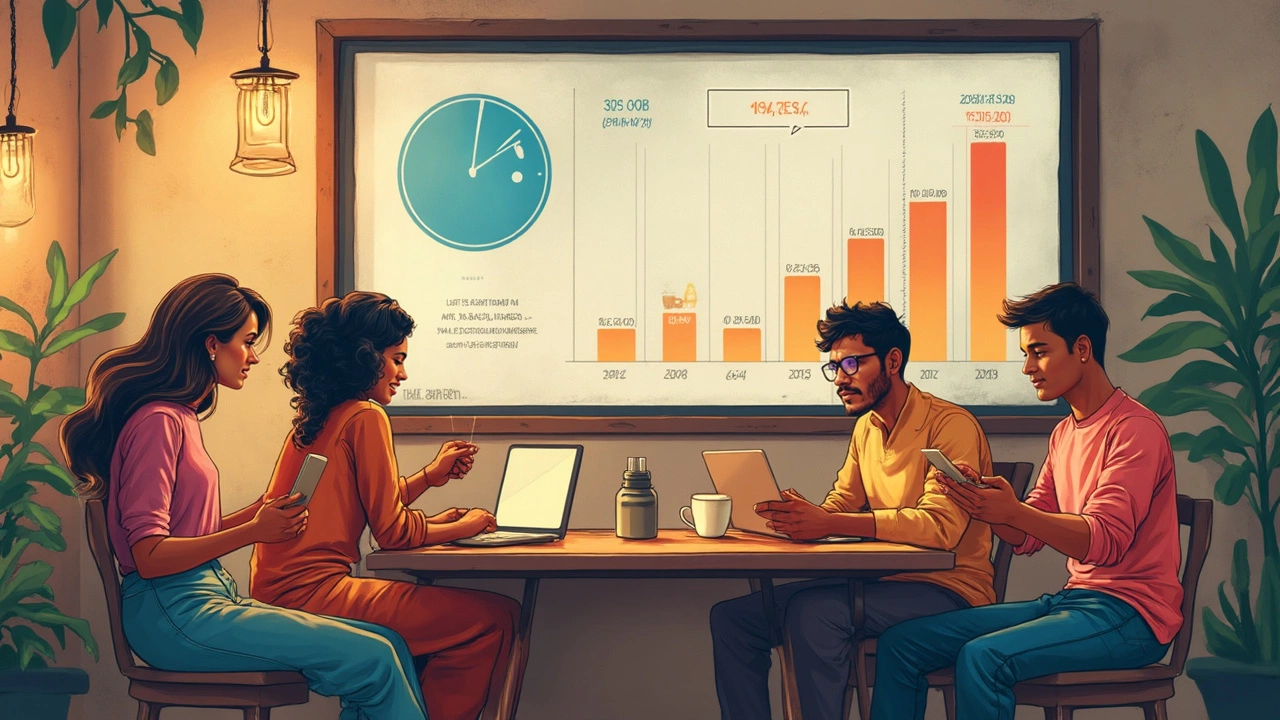If you've ever scrolled through social media and seen bloggers bragging about their income, it's tempting to wonder if that could be you. But the truth behind those flashy income reports is a lot more complicated. Most new bloggers start off making nothing, and some never even break the $100 mark. On the flip side, there are people who turn their blogs into full-time jobs and rake in more than $10,000 a month. So what's actually possible—and how hard is it to get there?
Blogging income isn't just one number. How much you earn depends on what you write about, how much traffic you get, the way you make money, and even where your readers are from. For example, someone writing about personal finance in the US will usually earn a lot more per view than someone writing casual travel tips for a local audience.
Most importantly, making money from a blog isn’t usually quick. It can take months to even see your first bit of cash. If you treat your blog like a business, focus on the right topics, and keep at it, the rewards do come—but it’s not a lottery ticket. You’ve got to know which income streams actually pay off and how to avoid mistakes that slow you down.
Instead of pie-in-the-sky promises, let's get real about what bloggers actually make, what influences those numbers, and what you can do to boost your own results—with zero sugarcoating.
- The Real Numbers: What Bloggers Actually Earn
- How Blog Monetization Works
- What Influences Your Blogging Income
- Tips to Increase Your Earnings
The Real Numbers: What Bloggers Actually Earn
So, what’s the honest answer to “how much can I make from a blog?” The short version: it’s all over the map. According to a 2024 survey by ProBlogger, over 60% of bloggers make less than $100 a month. That’s not enough for a fancy coffee a day. About 10% earn between $500 and $2,000 monthly, and only about 4% hit $10,000 or more per month. That's the reality check most folks don't hear about.
The top percentages you see online—those loud income reports from superstar bloggers—aren’t even close to average. The bulk of bloggers make small change unless they treat their blog like a real business. And even then, it takes time. If your goal is to hit a full-time income, you’ll need loads of traffic and the right mix of income streams.
You might be wondering, “How do these blogs actually make money?” The most common ways are:
- Ads (like Google AdSense or Mediavine): Smaller blogs earn a few bucks. Big ones can pull in $10 to $40 per 1,000 visits if their topics attract valuable advertisers.
- Affiliate marketing: Some blogs make $50 a month, others make $5,000, depending how much people trust their recommendations.
- Selling products or courses: Bloggers with a solid following often sell their own stuff, which can really boost earnings. But the average beginner usually makes little from this, at least at first.
- Sponsorships: Not common for new blogs, but established ones working with brands can make a few hundred to even several thousand dollars per mention.
If you’re busting your back on make money blogging searches and wondering if it’s rigged, you’re not alone. The numbers show most bloggers don’t hit it big. The ones who do are either in super profitable niches, have tons of traffic, or have been at it for years. So, making real cash from blogging is possible, but it’s not the gold rush a lot of people make it out to be.
How Blog Monetization Works
There’s no secret button to start making money from your blog. But there are some methods almost every successful blogger uses, and each one has its own pros and cons. The cool part? You don't need to stick with only one way to bring in cash—you can stack them together.
The most common way people start is ads. When you sign up for something like Google AdSense or Mediavine, you let them put ads on your site, and you get paid every time someone views or clicks those ads. Here’s the catch: if your blog doesn’t have much traffic, the money will be tiny. For example, in the US, display ads usually earn $10 to $30 per thousand views, but in other countries, it can be less than $3. That’s why a high-traffic blog in a strong niche pulls in more cash from ads alone.
Next up, affiliate marketing. This is where you recommend stuff—like books, tools, or services—and get a cut every time someone buys through your special link. Amazon Associates is everywhere, but you’ll earn more with programs like Bluehost for web hosting or high-ticket courses. Some bloggers go all in on affiliate links and make the bulk of their income from it. But to earn big, your make money blogging content needs to match what your readers actually want to buy.
Sponsored posts are another income stream. Brands pay you to write about their product or service because they want your audience’s attention. Pay rates vary like crazy (from $50 to several thousand dollars per post), depending on your blog’s traffic, niche, and how engaged your audience is. If you’re just starting, expect smaller deals, but as you grow, brands start reaching out with bigger offers.
A lot of bloggers eventually launch their own products. Think online courses, eBooks, merch, or printables. This is where the best margins are, but it takes the most work up front. Creating good products and marketing them to your readers means more control and more profit—no middleman skimming your earnings.
Finally, some advanced bloggers run membership sites or communities, where their fans pay monthly for exclusive content, coaching, or networking. If you’ve got a loyal tribe, this can turn your blog into a steady, predictable business.
The point is, you’re not locked into just one strategy. The best bloggers test, mix, and double-down on what clicks with their audience. Try out a few, dial in what pays off, and don’t put all your eggs in just one basket.

What Influences Your Blogging Income
Making real cash from a blog isn't just about putting up posts and waiting for the money to roll in. There are a bunch of factors that decide if you’ll earn chump change, or if you could turn your blog into a serious income stream. Here’s where things get real.
Make money blogging isn’t a copy-paste formula. The biggest factors at play are your blog’s niche, your audience size and demographics, traffic sources, and how you monetize. Even small tweaks can mean big changes in your earnings.
Let’s talk specifics:
- Niche: Some topics pay way better than others. Personal finance, business, tech, software, and health tend to have the highest earning potential because advertisers fork out more for those audiences. A food or travel blog might get more readers but still make less per visitor.
- Traffic: More visitors usually means more money, but what matters most is who those visitors are and where they come from. U.S., Canada, and Western Europe traffic is the most valuable. If most of your readers are from countries with lower buying power, advertisers don’t bid as high.
- SEO & Content Quality: If people can’t find your blog on Google, you’re missing out. Bloggers who invest time in learning SEO usually get more targeted readers, which can double or triple their income.
- Monetization Paths: Ads, affiliate links, sponsored posts, selling digital products—the combinations are endless. Some, like display ads, pay pennies unless you have serious traffic. Others, like high-commission affiliate offers or your own online course, can multiply your earnings.
Compare a hobby blog and a business-focused blog. According to the 2023 Blogging Income Report by Authority Hacker, only 23% of hobby bloggers reported making over $1,000 a month, while the same number jumped to 38% for those blogging with a clear business strategy.
| Factor | Low Income | High Income |
|---|---|---|
| Niche | Food, Lifestyle | Finance, Tech, Software |
| Main Audience Location | India, Southeast Asia | USA, Canada, UK |
| Monetization Type | Basic ads only | Affiliate + online courses |
| Monthly Traffic | <10,000 users | >50,000 users |
As Adam Enfroy, a well-known pro blogger, puts it:
“Great content alone won’t pay the bills—you need the right strategy and a business mindset if you want to earn serious money from your blog.”
If you’re after real earnings, look beyond pageviews. Get strategic about your niche, boost your traffic with solid SEO, and pick better ways to monetize. That’s where the real jump in blogging income happens.
Tips to Increase Your Earnings
If you want your blog to make real money, it's all about working smarter, not just harder. Plenty of bloggers get stuck writing post after post but never see real cash. Here’s how you can change that.
Make money blogging is about the right strategies, not just pumping out content. Focus on these key tips that actually move the needle:
- Choose topics that pay: Ads and affiliate programs pay more in some niches. Personal finance, tech, health, and business usually offer higher commissions and ad rates than lifestyle or general travel.
- Build your email list: Social media is flaky, but email lets you reach readers directly. Bloggers who grow even a small email list often see better affiliate sales and repeat visitors.
- Learn basic SEO: Most blog traffic comes from Google. If your posts show up in search, you get free readers every month. Focus on keyword research, writing helpful content, and getting links to your site.
- Mix up your income sources: Don’t rely on just ads or affiliates. Use digital products, courses, sponsored content—test what fits your topic and audience.
- Improve your site speed and design: A fast, easy-to-navigate blog keeps visitors around longer, boosts ad revenue, and helps you rank better on Google.
Curious about what actually works? Here’s what bloggers say pays most over time:
| Income Source | Beginner Success Rate | Potential Monthly Earnings |
|---|---|---|
| Ads (Display/AdSense) | High | $10 - $2,000 |
| Affiliate Marketing | Medium | $50 - $5,000 |
| Sponsored Posts | Low | $200 - $2,500 |
| Digital Products | Low (at first) | $100 - $10,000+ |
Bloggers who start seeing higher earnings usually combine a few of these strategies. For example, they use ads and affiliate links for a steady base and sprinkle in digital products or sponsored content for bigger spikes in income.
Finally, track everything. Free tools like Google Analytics and affiliate dashboards help you spot what’s working, so you don’t waste time on the stuff that isn’t bringing money in. Every successful blogger I know treats their analytics as a daily to-do.
